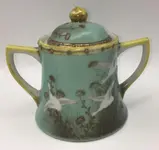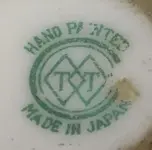Upvote
10
Navigation
Install the app
How to install the app on iOS
Follow along with the video below to see how to install our site as a web app on your home screen.
Note: This feature may not be available in some browsers.
More options
You are using an out of date browser. It may not display this or other websites correctly.
You should upgrade or use an alternative browser.
You should upgrade or use an alternative browser.
My Grandmothers tea set
- Thread starter coll
- Start date
That is really pretty. Thanks for sharing
Almy
Bronze Member
It is neat. The decoration looks oriental, but I am no expert. Is it to contain tea bags? Or sugar for tea?
Red-Coat
Gold Member
Welcome to Tnet.
Very pretty. Does it have this mark?:

Very pretty. Does it have this mark?:
- Aug 19, 2014
- 38,266
- 139,057
- Detector(s) used
- JW 8X-ML X2-VP 585
- Primary Interest:
- All Treasure Hunting
Royal Nippon. ?
- Aug 19, 2014
- 38,266
- 139,057
- Detector(s) used
- JW 8X-ML X2-VP 585
- Primary Interest:
- All Treasure Hunting
RC... perhaps... ATQ Japan

- Aug 19, 2014
- 38,266
- 139,057
- Detector(s) used
- JW 8X-ML X2-VP 585
- Primary Interest:
- All Treasure Hunting
Really there were a lot of makers of this... just image searched this.. sheesh .
river roamer
Bronze Member
- Dec 9, 2022
- 1,025
- 1,576
- Detector(s) used
- Excalibur II Excalibur 1000 Equinox 900
- Primary Interest:
- Beach & Shallow Water Hunting
Very nice Thanks for sharing
Red-Coat
Gold Member
RC... perhaps... ATQ Japan
Does the one you're showing have exactly the same decoration as the OP's?
This one does, and has a 'TT' mark for the Takito Company. They used a number of marks and that one was first used around 1920.


If it is from Takito, the wording for country of origin will help with a date. The one above is from the 1950s [*addition: or very late 1940s]
But we need the OP to tell us how it is marked (if at all).
Last edited:
- Thread starter
- #10
This is the sugar container I have a creamer 6 cups and saucers and 3 dessert plates. Unfortunately the tea pot and some other pieces were broken in the 1989 earthquakeThat is really pretty. Thanks for sharing
- Thread starter
- #11
Attachments
- Thread starter
- #12
This is the sugar container I have a creamer 6 cups and saucers and 3 dessert plates. Unfortunately the tea pot and some other pieces were broken in the 1989 earthquakeIt is neat. The decoration looks oriental, but I am no expert. Is it to contain tea bags? Or sugar for tea?
- Thread starter
- #13
Does the one you're showing have exactly the same decoration as the OP's?
This one does, and has a 'TT' mark for the Takito Company. They used a number of marks and that one was first used around 1920.
View attachment 2068479View attachment 2068480
If it is from Takito, the wording for country of origin will help with a date. The one above is from the 1950s [*addition: or very late 1940s]
But we need the OP to tell us how it is marked (if at all).
Attachments
- Thread starter
- #15
Attachments
Red-Coat
Gold Member
The mark in your picture is completely out of focus!
- Thread starter
- #18
It saysThe mark in your picture is completely out of focus!
made in
SWB
Japan
Red-Coat
Gold Member
Thanks for the clarification. Generally, I would prefer to see the actual mark rather than someone else’s interpretation of what it says… because of the possibility that smudged or poorly registered marks can be misread.
‘SWB’ rings no bells at all. Are you sure it’s not ‘SNB’ as shown below:

If so, that’s a Nagoya mark. Nagoya was both the name of a porcelain company in Japan, as well as being a city with a number of porcelain factories that also used the name generically. It’s uncertain what ‘SNB’ actually stood for, but perhaps one of the many workshops in that area.
Note that the ‘SNB’ mark may or may not be accompanied by the word ‘Nagoya’; may or may not include the words ‘Hand Painted’; and the ‘Made in…’ assignation can be either inside the circle mark or printed separately alongside it. Some pieces say ‘Nippon’ and some say ‘Japan’.
‘Nippon’ is the Japanese word for Japan but was outlawed by the US Custom Service in August 1921 by a ruling that it did not fulfil the requirements of the McKinley Tariff Act for origin marking, because it wasn’t an English word. Thereafter (until 1941 when imports stopped), the wording was “Made in Japan”. Imports didn’t resume until the late summer of 1947 when “Occupied Japan” was the required origin mark through to 1949 when the word “Occupied” could be dropped.
Unless you have family history for the items that suggests otherwise, my guess would be that this is post-war and made after 1949.
‘SWB’ rings no bells at all. Are you sure it’s not ‘SNB’ as shown below:
If so, that’s a Nagoya mark. Nagoya was both the name of a porcelain company in Japan, as well as being a city with a number of porcelain factories that also used the name generically. It’s uncertain what ‘SNB’ actually stood for, but perhaps one of the many workshops in that area.
Note that the ‘SNB’ mark may or may not be accompanied by the word ‘Nagoya’; may or may not include the words ‘Hand Painted’; and the ‘Made in…’ assignation can be either inside the circle mark or printed separately alongside it. Some pieces say ‘Nippon’ and some say ‘Japan’.
‘Nippon’ is the Japanese word for Japan but was outlawed by the US Custom Service in August 1921 by a ruling that it did not fulfil the requirements of the McKinley Tariff Act for origin marking, because it wasn’t an English word. Thereafter (until 1941 when imports stopped), the wording was “Made in Japan”. Imports didn’t resume until the late summer of 1947 when “Occupied Japan” was the required origin mark through to 1949 when the word “Occupied” could be dropped.
Unless you have family history for the items that suggests otherwise, my guess would be that this is post-war and made after 1949.
Top Member Reactions
-
 3529
3529 -
 2094
2094 -
 2042
2042 -
 1156
1156 -
 1128
1128 -
 926
926 -
 850
850 -
 815
815 -
 810
810 -
 782
782 -
 772
772 -
 535
535 -
 531
531 -
 452
452 -
 452
452 -
 437
437 -
E
424
-
 412
412 -
 412
412 -
 406
406
Users who are viewing this thread
Total: 2 (members: 0, guests: 2)







